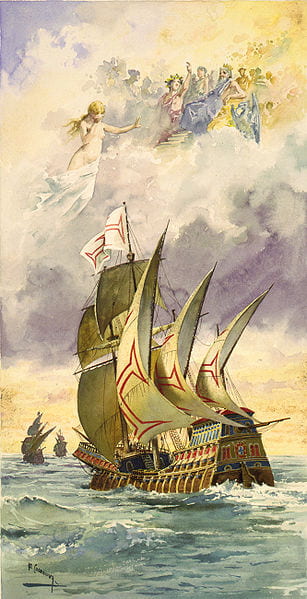Portugal
First published: 1572
Luis Vaz de Camões,
The Lusiads
(Os Lusíadas)
Camões’ Os Lusíadas is not technically a New World epic, as it is sometimes called, since most of its action takes place in Africa and India. Yet it clearly exemplifies a burgeoning genre of epic poems in the sixteenth century that take European exploration and colonialism as their subject. Like these poems (some of which it inspired), the Os Lusíadas strenuously attempts to use a classical, mostly Virgilian, model of epic to represent European imperialist campaigns. In doing so, Camões’ poem gives support to the argument that an imperial ideology undergirds Virgil’s representations of seafaring and cross-cultural contact.
The subject of the Os Lusíadas is Vasco da Gama’s voyage from Portugal to India in 1497–8, a campaign that was undertaken to establish a Portuguese trading network in the Indian Ocean. Although da Gama eventually reaches Calcutta, most of the poem’s ten cantos take place on and around the African coast. In fact, da Gama’s biggest impediment to reaching India is the threat posed by the African and Arabic peoples of the Mozambique Channel.
The arduousness of the African coastal journey gives Camões the opportunity to imitate the “wandering” plots of Homer’s Odyssey and the first half of Virgil’s Aeneid, but it also spurs him to represent Portuguese imperialism as a clash of religious, racial, and linguistic differences. In the poem’s mapping of the African continent, the extremities of the known world are inhabited by peoples who are vastly different from the Portuguese in morals, culture, technology, and skin color. Hence, in canto 5, when da Gama’s men reach Saint Helena Bay (near Cape Town), they encounter “um estranho vir, de pele preta” [“a stranger with a black skin”] (5.27) whose speech is utterly unintelligible to them and who seemed “selvagem mais que o bruto Polifemo” [“wilder than Polyphemus”] (5.28). The episode is based on an incident that actually took place during da Gama’s journey—his meeting with the Khoikhoi, an indigenous people in South Africa—but Camões fashions it into the prototypical scene of a colonial encounter, complete with the usual racist language and ideology.
Camões’ comparison of the Khoikhoi man with the cyclops Polyphemus points to one of the most frequently discussed (and most controversial) aspects of the Os Lusíadas: its heavy integration of classical material. In the poem, classical figures are actual characters, not simply descriptive metaphors. Venus, reprising her role in the Aeneid, is an ardent champion of da Gama, while Bacchus—orientalized by Camões more than he is in Ovid or Euripides—is an enemy who frequently conspires with Muslims in Africa and India in an attempt to thwart the Portuguese campaign. In this way, the classical model helps Camões make polarizing distinctions between Christian and Muslim. By far, Camões’ most remarkable feat of classical imitation is his creation of the giant Adamastor, whom da Gama encounters at the Cape of Good Hope. Adamastor is a menacing Titan who had once fought against Jove until his love for the nymph Thetis caused him to abandon the war and ultimately to be transformed into a massive promontory. Sometimes read as a grotesque figure for Islam, Adamastor shows that Camões was as good a reader of Ovid and Theocritus as he was of Homer and Virgil.
Perhaps one of the most unusual characteristics of the Os Lusíadas is that it is a heroic epic that ends with a decisive failure. Da Gama fails to achieve the primary objective of his long naval campaign—a political and economic alliance between Portugal and India—despite the willingness of the Samorin and the constant support of the gods. When da Gama sails away from Calicut after this botched campaign, Camões describes his accomplishments as though they are a consolation prize:
Mas, como aquela terra, que se estende
Pela Aurora, sabida já deixava,
Com estas novas torna à pátria cara,
Certos sinais levando do que achara. (9.13)
But at least those lands stretching
To the dawn were now known to the world
And at long last his men were homeward bound
With proofs on board of the India he had found.
Even more unusual is the other “consolation prize” given to da Gama’s men after the failed Indian campaign. While en route back to Portugal, Venus diverts da Gama to a magical island that she and Cupid have meticulously prepared to receive the Portuguese fleet. The island is an earthly paradise full of sumptuous delights and beautiful nymphs who entertain da Gama’s men (in every possible sense) as soon as they arrive.
In almost any other epic, such a paradise would be a clear sign of moral depravity. For example, Alcina’s island in Ariosto’s Orlando Furioso (which Camões imitates here) was typically read by Renaissance readers as a den of sensual iniquity that signals the hero’s moral weakness and prevents him from fulfilling his moral, Christian duty. Camões knew this reading, and he follows it closely in other parts of the Os Lusíadas; the kingdom of Malindi, for example, is another paradisiacal site whose sumptuous entertainment blatantly distracts da Gama from his imperial mission. How, then, to read the Isle of Love (as it is often called), which occupies most of the last two cantos of the poem? Early critics of the Os Lusíadas attempted to explain it by reading it allegorically, interpreting the sexual union of Portuguese sailors and Venusian sea-nymphs as a symbol of “Portugal’s glory and lordship over the ocean” (Bell 88). Camões himself encourages such a noble reading of the magical island by making it the site of a grand epic vision of Portuguese imperial power: in canto 10, Tethys, the nymph paired with da Gama, organizes a sumptuous banquet where a nymph “cüa voz dhüa angélica Sirena” [“with the siren sound of an angelic voice”] (10.5) sings for the Portuguese. Her song is a long prophecy of future Portuguese victories in India—a prophecy that manages to summarize most of the major figures and events of Portuguese imperial history in the first half of the sixteenth century.
Even this final ennobling vision, however, is constantly undermined by the realities of that same history. The great victories in Africa and Asia sung by the nymph establish Portugal’s dominance in the region, but only for a short period. By the time the Os Lusíadas was published in 1572, the difficulty of managing a large trading network over such a vast geographical area was clear. Although Camões’ poem is an ardent appeal to continue the project of Portuguese imperialism, it is also a somber warning to Camões’ patron, the “mad” King Sebastião, of the importance—and the difficulty—of wise governance.
Joseph M. Ortiz
University of Texas at El Paso
Works Cited
Bell, Aubrey F. G. Luis de Camões. Oxford: Oxford University Press, 1923.
Luís de Camões. Os Lusíadas. Edited by Emanuel Paulo Ramos. Porto: Porto Editora, 1974.
Luís Vaz de Camões. The Lusíads. Translated by Landeg White. Oxford University Press, 1997.
Resources
Editions
Luís de Camões. Os Lusíadas. Edited by Emanuel Paulo Ramos. Porto: Porto Editora, 1974.
Luís Vaz de Camões. The Lusíads. Translated by Landeg White. Oxford University Press, 1997.
Critical Studies
Hart, Henry H. Luis de Camoëns and the Epic of the Lusiads. Norman: University of Oklahoma Press, 1962.
Macedo, Helder. “The Lusiads: Epic Celebration and Pastoral Regret.” Portuguese Studies 6 (1990): 32–37.
Pierce, Frank. “The Place of Mythology in The Lusiads.” Comparative Literature 6 (1954): 97–122.
Quint, David. Epic and Empire: Politics and Generic Form from Virgil to Milton. Princeton: Princeton University Press, 1993.
Torrance, R. M. “‘Se Fantàsticas São / Se Verdadeiras’: The Gods of the Lusíads on the Isle of Love.” Modern Language Notes 80 (1965): 210–34.
The above bibliography was supplied by Joseph M. Ortiz (University of Texas at El Paso).

